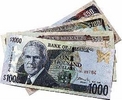Commentary - J$2 = US$1! Absurd, absolutely outrageous!
Published: Friday | May 22, 2009

Wilberne Persaud, Financial Gleaner Columnist
I awoke from a dream. The news was: dollar appreciates to the unprecedented level of J$2 to US$1.
Was I transported back to 1962? Even so, I was at that time in high school at the Queens College in Guyana - couldn't care less about the Jamaican dollar, any dollar really.
Life was as cool as the breezes coming in from the Atlantic through efficient wooden louvre windows and our cricket and football field beckoned even as 'Breezy' tried to teach history and 'balance' mathematics. Breezy got his alias from his real name Eyre - so very uncreative on our part - while Balance took his from his penchant for having his horn-rimmed glasses perched peculiarly balanced on his nose.
But it was historian Bobby Moore who gives me the clincher for this outrageous idea.
He was fond of the term 'in the last analysis, in the final analysis'; he would cogently summarise some complex bit of historical conjecture, leaving us with a debatable yet eminently reasonable view of the particular conundrum he had so utterly confused us with during the previous 40 minutes.
Then again, that was the time of almost endless turmoil in the Cold War-instigated destabilisation and race riots culminating in the infamous Friday February 16 fire bombings in Georgetown. Jamaican dollar devaluations began in a period of similar if not as perilous instability in prevalent Cold War ideas.
Reagan's "Mr Gorbachev tear down this wall" hadn't happened - the Berlin Wall continued as enduring symbol of Cold War ideological struggle. Perhaps we can now discuss these events and policy derivatives without the heat which so dominated debate in the 1970s. Why not convey these ideas as dream-like with that 'final analysis' perhaps as conjecture, even long run strategic goal.
Jamaican dollar devaluations are rooted in the original sin of perhaps wacky thinking that set its value at independence, at the outrageous level of J$1 equals US$1.20.
With no checking whatsoever, I am willing to wager that it was a matter of pure convenience or could it be laziness?
The Jamaican pound was going to be changed to the Jamaican dollar. What rate should be chosen? If its value would be half a pound then - voila! - with US$2.40 to the British pound then US$1.20 equals J$1.
Nobody thought the process through.
Income distribution in Jamaica was among the world's most unequal. How far away was Miami - the United States. People called it Kingston 13. Travel cost was cheap. Foreign-produced goods were at a premium; even a pack of American cigarettes could be symbol of higher status.
If nobody thought of these things, the population did. Migration streams to the United Kingdom and USA had not yet fully blossomed in 1962 as they bloomed by the 1970s. But any thoughtful Jamaican shopper recognised the wisdom of a trip to Miami from which J$100 would mine five shopping baskets of true goodies from 'farin' (that is, overseas) as opposed to perhaps two if the same money was spent for identical goods at home.
And these rational, thoughtful Jamaican shoppers commanded the lion's share of the country's income.
So whereas fresh fruit, vegetables and ground provisions (food) would be purchased from Agricultural Marketing Corporation (AMC) shops, other stuff would be mined in Miami. AMC subsidised the urban middle and upper class without really improving the lot of small farmers in productive rural Jamaica, who even today toil with deplorable feeder roads and infrastructure for their agricultural enterprise.
Recall bauxite and tourism earnings were on a roll. Industrialisation behind protective barriers in economically suboptimal scale, operationally high-cost plants were creating jobs.
Much too few, yet a pretty large segment of the population bought into the prosperity which by the 'better must come' days of 1972 was evidently not trickling down to the vast majority of Jamaicans.
So under stress of attempts to deal with pressing social and economic issues the people clamoured for they elected Michael Manley with a transformative mandate, the economy was almost immediately further hit by the 1973 oil crisis.

It is settled understanding that a good bit of Jamaica's inflationary impulses are imported. Attempts to immunise the population from these stresses while implementing much-needed social programmes, all in a period of perilous foreign exchange shortage sent us into the hands of an International Monetary Fund still in Cold War mode of privatisation and evaluation - the Washington consensus.
Does anyone still believe devaluation of the Jamaican dollar is an effective policy tool for dealing with the economy?
Over a quarter century of this flexible exchange rate - read 'devaluation' - model seems to suggest it doesn't work.
Then there is dollarisation. Should we simply abandon the Jamaican dollar and use the US dollar? Should we recall the currency and issue a new one at the exchange rate of J$2 to US$1? No one will believe this could be for real.
We try to strengthen our net international reserves in the hope that as it grows, economic actors will experience bolstered confidence.
Sometimes in reality, we even borrow to do this. The perverse outcome though, seems to be that its growth has no positive impact while shrinkage has immediately negative ones. In peoples' mindset the Jamaican dollar has no place to go but down.
It may never be known what degree of foreign exchange holdings private Jamaican citizens and corporations possess, but one thing is for certain, in the climate of unending devaluations no one in his/her right mind will contemplate exclusive holdings of financial wealth in Jamaican dollars.
Perhaps, in the final analysis, we do need to consider an absurd, dreamlike outcome of a new J$2 = US$1 as a believable currency.
Alternatively, announce a fixed exchange rate policy, J$90 = US$1, and run it for a sufficiently substantial period to change the mindset.
wilbe65@yahoo.com

















